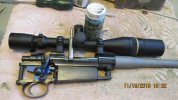waveslayer
Well-Known Member
All new rings do not need to be lapped... so honestly buy better rings! Simple and easy, you'll be way ahead over lapping.
 Help Support Long Range Hunting Forum
Help Support Long Range Hunting Forum
Perfect rings mounted on mis-aligned action holes or imperfect rails may still need lapping.All new rings do not need to be lapped... so honestly buy better rings! Simple and easy, you'll be way ahead over lapping.
Closely looking at the pic I think you should very carefully re set the pointed bars along with uniform circular tightening the top half of the rings just enough to put slight pressure on the bars. If there is no more misalignment or less than this pic then I say you are good to go ahead and lap. Probably reposition the bottom half to begin with before rechecking the bar alignment, basically double check it.Just got a scope mounting kit. Never lapped my rings before. Mounting scopes and reloading like my father taught me was always simple, then I was introduced to this site…I Spend way to much time reading and sucking in information over the past year or so.
Mounted my scope and it was shooting wild, so I pulled out the new kit. Using Talley rings and bases on my fathers old browning Mauser action 3006.
How much can I sand off ? Is this to much ?
Will the scope work again ?
Garbage in garbage out. No they don't read up on all good rings, do not lap! If thats an issue it's not the rings... you're masking the problemPerfect rings mounted on mis-aligned action holes or imperfect rails may still need lapping.
If you are mounting individual rings to an action that is not perfectly machined and drilled, lapping the rings is probably preferable to machining the action. Even a rail can be slightly deformed when torqued to an action that is not perfect. I agree that good rings may not need lapping, but even if it's not the fault of the rings, lapping may be the best option.Garbage in garbage out. No they don't read up on all good rings, do not lap! If thats an issue it's not the rings... you're masking the problem
It can also be a problem even if you are mounting rings to a pic rail if the pic rail has been distorted.If you are mounting individual rings to an action that is not perfectly machined and drilled, lapping the rings is probably preferable to machining the action. Even a rail can be slightly deformed when torqued to an action that is not perfect. I agree that good rings may not need lapping, but even if it's not the fault of the rings, lapping may be the best option.

ExactlyPerfect rings mounted on mis-aligned action holes or imperfect rails may still need lapping.
Just got a scope mounting kit. Never lapped my rings before. Mounting scopes and reloading like my father taught me was always simple, then I was introduced to this site…I Spend way to much time reading and sucking in information over the past year or so.
Mounted my scope and it was shooting wild, so I pulled out the new kit. Using Talley rings and bases on my fathers old browning Mauser action 3006.
How much can I sand off ? Is this to much ?
Will the scope work again ?
From the original poster's picture, assuming the alignment bars are 1", there is about a 1/64" misalignment. The alignment bars amplify the misalignment, so the amount of lapping necessary is probably a few thousandths of an inch. I would make sure the bases are set and torqued properly, with no visible gaps. Then lap for a few minutes and check how much progress is made. That would tell you the likelihood of success.General question for all those that are in favor of lapping... How much lapping do you need to do fix the problem the OP originally posted about? When do you stop lapping to avoid any risks to the integrity of the rings holding a scope zero?
or can't you just get good rings like Seekins, SPUHR, ARC , skip the lapping and adjust your windage? How much windage are you dialing?...